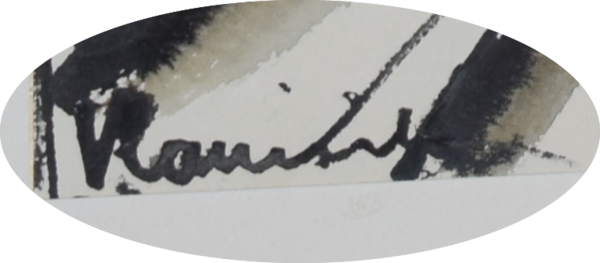

(Paris, 1876 - Rueil-la-Gardelière, 1958)

The eldest of five children from a Flemish family, Maurice de Vlaminck was raised in an environment of somewhat bohemian music lovers. From the age of twelve, he painted landscapes of the banks of the Seine. He left his family at 16 and moved to Chatou near Versailles and became a bicycle racer, which enabled him to earn a better living. At 18, he met Suzanne Berly who would later become his wife.
After an illness around the age of 20, Vlaminck left the sport and gave violin lessons. He also followed courses of the painter Robichon, but he quickly tired of his academic training.
In 1900, he happened to meet Andre Derain on a train, with whom he became friends and resumed painting. A dissenting spirit, he then became passionate about anarchist ideas and wrote a few articles for the Libertarian.
Vlaminck discoverd Van Gogh’s painting, and he immediately recognized in the painter the instinct for pure color and chromatic violence which perfectly matched his own training as a self-taught man and his rebellious temperament. He met Henri Matisse and then decided to devote himself definitively to painting.
Marked by the First World War in which he participated from 1914 to 1918, like his friend Andre Derain, he retired to Eure and Loire after his demobilization.
While Derain overcame the trauma of war by making an about-turn towards the pictorial tradition, Vlaminck renounced colorful explosions and then engaged in the painting of tormented landscapes, in dark tones which reflected the trauma of war.
He moved to Valmondois in 1919 and married Berthe Combes as his second wife, while his exhibition at the Galerie Druet was a real success.
Starting to increase internal confinement, his motto became, "If you are a painter, look only in yourself".
What mattered to him was reality in its historical moment. Painting to him was simply the language of emotions.
In 1925, Vlaminck moved to "La Tourillière", where he remained until the end of his life. At the same time as painting, he wrote and published in 1929 "Dangerous Turning" where he expressed all his dissatisfactions and his revolts, by enclosing himself in an isolation turned towards painting, his passion for Negro art, and his admiration of nature.
He exhibited again in Paris in 1933 at the Palais des Beaux Arts, then in New York in 1937.
On the eve of the second war, in May 1939, Vlaminck gathered his friends in Paris and burned a portrait of Adolf Hitler "who allowed himself, as a building painter, to affirm that all the artists of the French School, the Braque, Derain, Gauguin, Laurencin, Valadon, Kisling, Matisse .... were degenerate painters ".
In 1953, he published "Landscapes and Characters" in which he continued to express his revolt.
In 1956, the Galerie Charpentier organized a large exhibition for him which provoked a debate between critics who considered him to be the traitor of modern painting, while others considered him to be the master of true modernism in the composition of his landscapes.
He died two years later in his manor of "La Tourilliere" in Rueil la Gadeliere in Eure-et-Loir.